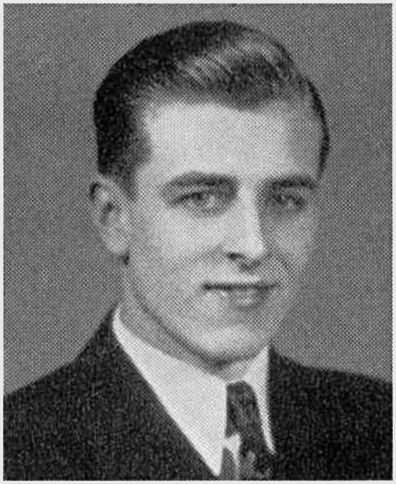Paul Kenneth Churm was born at Milwaukee, Wisconsin on October 5, 1918, and later lived in Chicago, Cook County, Illinois. His parents were Vernon Wesley Churm (6 May 1890 29 Apr 1952), who was born at Peshtigo, Marinette County, Wisconsin; and Catherine A. (Mulvaney) Churm (abt 1894 19 May 1957), who was born in Wisconsin. In June 1917 the family home was at 1017 21st Street, Milwaukee, Wisconsin, and his father was a sales supervisor for Maxfer Truck and Tractor Company in Chicago, Illinois. The family lived in the Milwaukee area until at least 1935. In April 1940 they lived at 4518 Hazel Avenue, Chicago, Illinois, and his father was an agent for an advertising company. By October 1940 they lived at 903 Sunnyside Avenue in Chicago, about one block south of their previous address and close to Lake Michigan.
He had a brother, James Vincent 'Jim' Churm (20 May 1917 12 Jun 1999). He graduated from Nicholas Senn High School in Chicago in June 1938. In 1940 he worked as a hotel desk clerk, and his brother James worked as a hotel elevator operator. He registered for the draft at Chicago on October 16, 1940. (His brother James registered on the same day.) He was 5 feet 7 inches tall, weighed 135 pounds, and had brown eyes and brown hair. He completed at least two years of college and enlisted in the U.S. Army by 1943.
He completed Army Air Forces flight engineer and aerial gunnery training, and was assigned to the heavy bomber crew of Lt Doyle L. Simons. In December 1943 the Simons crew began B-24 crew training at Davis-Monthan Field in Tucson, Arizona. In January 1944 the crew was assigned to the 838th Bomb Squadron of the 487th Bomb Group at Alamogordo Army Air Base, New Mexico. There they completed B-24 crew training, and deployed with the Group to England in March 1944. They flew B-24H 41-29479 'The Big Bad Wolf' from Alamogordo, New Mexico to Lavenham, England via the southern Atlantic ferry routea journey of about 10,000 milesand arrived at Lavenham by mid-April 1944.
The 487th Bomb Group was based at U.S. Army Air Forces Station 137, near Lavenham, Suffolk, England, and was part of the 8th U.S. Army Air Force in Europe. After the Group arrived in England, Lt Simons was grounded with appendicitis, and was replaced as First Pilot by 2/Lt Lorin D. McCleary Jr.
On May 11, 1944, the McCleary crew took off from Lavenham in B-24H 42-52444 on a mission to bomb the railroad marshalling yards at Chaumont, France. The secondary target was Troyes. The 487th Bomb Group formation never reached the target. Navigational error resulted in the formation flying over accurate German flak guns guarding the airfield at Chateaudun, France. Sgt Barboza and eight of his crewmates were killed in action when their aircraft was shot down by flak over Chateaudun. Sgt Cosme Marquez, a friend of Sgt Barboza, was flying with Lt Olen Huff's crew in B-24 41-29525 off McCleary's right wing. He said: "McClearys plane was hit 25 or 30 yards to our left. I saw the waist gunners struggling to get out. I was yelling, Bail out! Bail out! but they didnt make it. Barboza was on his fifth mission and was killed in the ball turret."
The aircraft took a direct flak hit in the nose and flight deck and started burning at the engines. It went into a dive, exploded in the air, and crashed three kilometers east of Varize near Bazoches-en-Dunois. One man, Staff Sergeant Harold E. Owens, survived. He wrote: "At approximately 1145 we were hit by flak in the nose, which resulted in the death of Lt Victor Kramer, navigator, Sgt Paul Churm, top turret gunner, and S/Sgt Eugene McKee, radio operator. The plane immediately burst into flames, we were flying at an altitude of approximately 11,000 feet, a few seconds later the plane started into a dive, and exploded in mid air, with the result that I was blown clear of the plane. I managed to pull my ripcord and landed eight miles north of Chateaudun, France. I made a safe landing and at a distance of one quarter of a mile I saw the plane completely wrecked and on fire. I was the only member of the crew who parachuted to safety. I did not go near the plane because I knew the bombs had not exploded. I hid in the woods and about five minutes later the bombs exploded."
The dead were recovered by German troops, who buried them at the Grand Cimetiθre in Orleans, France. After the war, Sgt Churm's remains were reinterred at Epinal American Cemetery, France.
B-24H 42-52444 crew:
McCleary, Lorin D 2/Lt Pilot KIA
McCoy, Ernest E 2/Lt Copilot KIA
Kramer, Victor S 2/Lt Navigator KIA
Perry, Joseph D 2/Lt Bombardier KIA
Owens, Harold E S/Sgt Engineer POW
McKee, Eugene S/Sgt Radio Operator KIA
Frey, Arthur C Sgt Nose Turret KIA
Churm, Paul K Sgt Top Turret KIA
Barboza, Clemente M Sgt Ball Turret KIA
Knapp, Dale L Sgt Tail Turret KIA
Source of information: Paul M. Webber, www.findagrave.com

